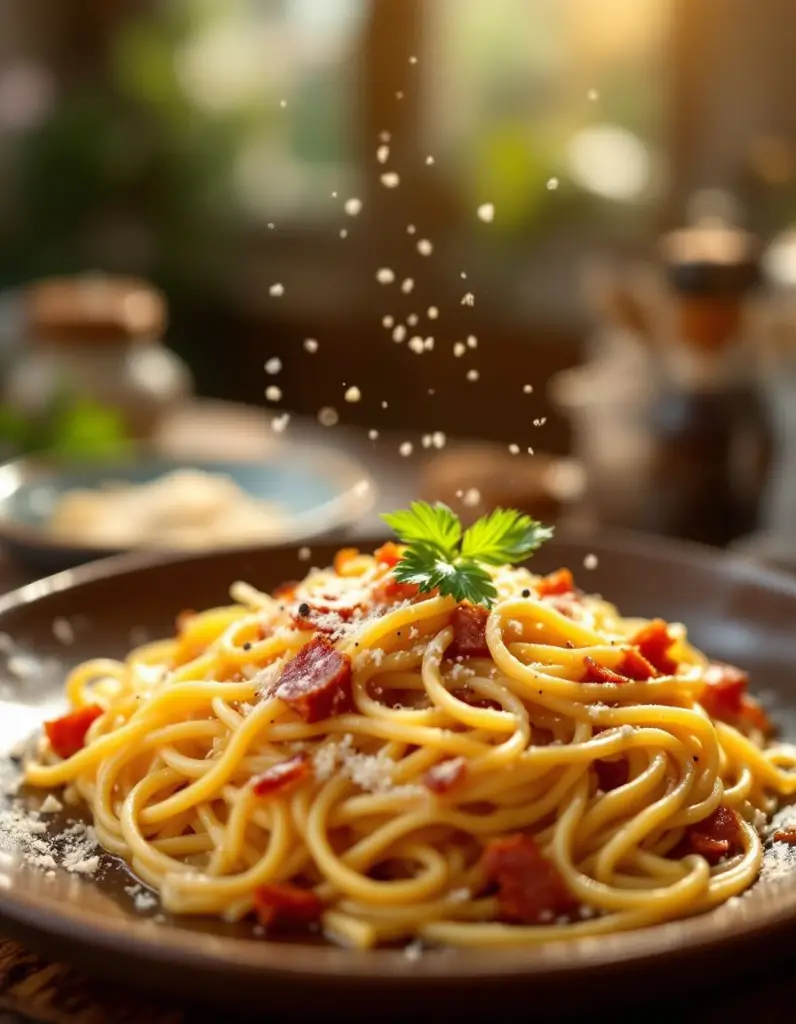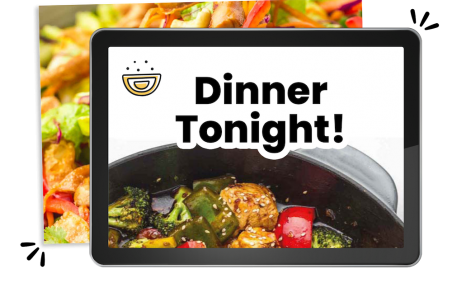Classic Spaghetti Carbonara: A Timeless Italian Delight
Classic Spaghetti Carbonara is an Italian masterpiece that captures the essence of comfort food. This dish combines simple ingredients to create an unforgettable flavor experience that is rich, creamy, and utterly satisfying. Imagine twirling your fork around al dente spaghetti coated in a velvety sauce made of eggs, pecorino cheese, and crispy pancetta. Each bite brings together the saltiness of the cheese and meat with the smoothness of the egg, creating a harmony of taste that lingers on your palate. It’s not just a meal; it’s an experience that transports you to the streets of Rome.
The beauty of Spaghetti Carbonara lies in its simplicity and the quality of its ingredients. As you gather around the table with family or friends, the aroma of sizzling pancetta and fragrant garlic fills the air, setting the stage for a delightful evening. Whether it’s a romantic dinner or a casual get-together, this classic Italian dish promises to impress and satisfy even the most discerning food lovers. With its rich flavors and creamy texture, it’s no wonder that Carbonara is a favorite among many around the globe.
Quick Recipe Highlights
- Flavor Profile: This dish offers a beautifully balanced blend of savory, creamy, and slightly tangy flavors, making every bite a delight.
- Texture: The spaghetti’s chewiness contrasts beautifully with the crispiness of the pancetta and the luscious creaminess of the sauce.
- Aroma: The dish is aromatic, featuring notes from the garlic and the sizzling pancetta that tantalize your senses.
- Visual Appeal: The plating is stunning, with golden pasta glistening under a sprinkle of freshly cracked pepper and a sprinkle of cheese.
- Skill Level Needed: Although it seems complex, creating a perfect Carbonara is achievable for home cooks with basic skills, making it accessible and rewarding.
- Special Equipment: All you need is a pot, a pan, and a mixing bowl to whip up this incredible dish, no fancy gadgets required!
Recipe Overview
- Difficulty Level: This recipe is classified as medium difficulty due to the timing of cooking processes, but with careful attention, you can achieve perfect results.
- Category: Classic Spaghetti Carbonara fits perfectly in the pasta category and is a popular choice for main meal sections in Italian cuisine.
- Cuisine: Italian cuisine is celebrated for its rich flavors and fresh ingredients, and Carbonara exemplifies the heart of this culinary tradition.
- Cost: The ingredients for Carbonara are generally affordable, making it a cost-effective option for a hearty meal.
- Season: This dish is enjoyed year-round but is particularly comforting during the cooler months when warmer meals are desired.
- Occasion: Spaghetti Carbonara is ideal for family dinners, social gatherings, or even a special date night; it’s a versatile dish for varied occasions!
Why You’ll Love This Recipe
The classic Spaghetti Carbonara is a dish that excites the taste buds with its dynamic flavor profile. The creamy sauce envelops the pasta perfectly, while the savory pancetta adds a satisfying crunch with each bite. The simplicity of the ingredients only enhances the overall experience, allowing each flavor to shine brightly. You might find it hard to resist a second helping!
In addition to its delicious taste, this recipe offers convenience and quick preparation. With a total time of about 30 minutes, it’s perfect for busy weeknights or impromptu gatherings. You can have a gourmet meal on the table without extensive prep work. The straightforward steps make it easy for anyone to replicate this dish in their own kitchen, ensuring that you can enjoy a restaurant-quality meal at home.
Nutritionally, Carbonara can be a balanced meal when paired with a side of vegetables or a fresh salad. The use of eggs provides a great source of protein, while the pasta offers carbohydrates for energy. When made thoughtfully, this dish can cater to various dietary needs while satisfying hunger with its richness.
Practically, Spaghetti Carbonara holds a social aspect as well. It’s a dish that brings people together around the table, encouraging laughter and conversation over shared plates. The communal experience of enjoying a classic Italian dish fosters connection and warmth, making it a great choice for entertaining friends and family.
Lastly, the affordability of the ingredients makes this recipe accessible to many. Even while enjoying a fine culinary experience, you won’t stretch your budget. Classic Spaghetti Carbonara is a fine example of how simple ingredients can create something truly delightful, proving that cooking can be both an art and a joy.
Historical Background and Cultural Significance
Spaghetti Carbonara has its origins deeply rooted in Italian cuisine, particularly in the Lazio region, where Rome is located. Its invention is often attributed to the mid-20th century, with tales suggesting that it was created by Italian charcoal workers (‘carbonari’). The simplicity of the dish reflects the practicality of these workers who needed a satisfying, energy-rich meal.
Culturally, Carbonara is not just a meal; it represents a piece of Italy’s culinary heritage. It embodies the Italian philosophy of “fare la scarpetta,” which means to savor every last bite of food, often using bread to wipe the plate clean. Carbonara encourages sharing and savoring, emphasizing community and connection.
Over the years, the recipe has evolved, with various regions of Italy adding their personal twists. While traditionalists hold firm to the original components of eggs, cheese, pepper, and pork, modern variations have emerged, introducing ingredients like cream or vegetables. These adaptations showcase cooking’s adaptability and the creativity of home cooks exploring outside traditional limits.
Regional variations further highlight the dish’s significance across Italy and beyond. Different provinces may use unique local ingredients or methods, reflecting their culture and contributing to the global appreciation for this delicious carbonara. The dish celebrates the diverse history of Italian cuisine while maintaining a beloved status among food lovers worldwide.
Ingredient Deep Dive
Spaghetti is the heart of Carbonara, providing the base for the dish. Roman tradition calls for spaghetti, but you can also use fettuccine or bucatini. As a staple in Italian cuisine, it has historical significance dating back to the 12th century. Spaghetti contains carbohydrates which are a primary energy source for the body, making it an excellent inclusion in any meal. When selecting spaghetti, look for high-quality, durum wheat pasta for better texture and flavor, and ensure to store it in a cool, dry place.
Pancetta plays a crucial role in imparting rich flavor to the dish. This Italian bacon adds a delightful saltiness and texture, key to the overall experience of Carbonara. Pancetta is often sold in thin slices and is made by curing pork belly with spices, enhancing its flavor. Nutritionally, it contributes protein and fat, so it’s important to use it judiciously. When choosing pancetta, always select a good quality product, preferably from an Italian supplier. Store it in the fridge and use it within a week for freshness.
Eggs are vital for creating the creamy sauce that binds the dish. Traditionally, fresh eggs from free-range chickens are preferred for the best color and flavor. Eggs are a great source of protein and contain numerous vitamins and minerals, making them an essential part of a well-balanced diet. To achieve the perfect sauce, use high-quality eggs, ideally from a local farmer’s market. Store eggs in the refrigerator and aim to use them within their expiration date to ensure their quality.
Pecorino Romano cheese adds the characteristic tangy flavor to Carbonara. This hard cheese, made from sheep’s milk, not only enhances the taste but also adds richness and depth. It’s a source of protein and essential fatty acids. When selecting cheese, look for an authentic Pecorino Romano rather than generic hard cheese for the best results. Store any leftover cheese in the refrigerator, wrapped tightly to maintain freshness.
Common Mistakes to Avoid
- Using low-quality ingredients: Opting for subpar ingredients can lead to an unsatisfactory end product. Always choose the freshest eggs, high-quality cheese, and quality pasta.
- Overcooking the pasta: Cooking pasta until mushy will ruin the texture of your dish. Always aim for al dente, as it will continue to cook slightly when mixed with the sauce.
- Adding cream: Traditional Carbonara relies solely on eggs and cheese for creaminess. Adding cream can alter the authentic taste and texture of this classic dish.
- Not mixing the sauce properly: Failing to blend the egg mixture with hot pasta can lead to scrambled eggs. Mix them off the heat for smooth results.
- Using precooked pancetta: Pre-cut or precooked pancetta may lack flavor. Freshly sauté it to develop deeper flavors essential for Carbonara.
- Forget to reserve pasta water: Not saving some pasta water can leave your sauce too thick. Use it to adjust the sauce’s consistency when needed.
- Inadequate seasoning: Pasta needs seasoning! Ensure you’re adding enough salt to the water and seasoning your sauce to enhance flavors.
- Rushing the process: Cooking Carbonara requires some care in timing, especially when combining the sauce with the pasta. Take your time for the best results.
Essential Techniques
Cooking the Pasta: Cooking pasta is fundamental to this dish. Learn to master the timing and don’t forget to salt the water well to enhance the pasta’s flavor. Always test for doneness a minute before the package suggests. Look for a firm bite, known as al dente.
Making the Sauce: The key to a creamy sauce without scrambling the eggs is to mix them off the direct heat. Once you add the hot pasta, the residual heat will cook the eggs just enough without overcooking them. Visual cues include a smooth, glossy sauce that clings to the spaghetti.
Pro Tips for Perfect Classic Spaghetti Carbonara
One essential tip is to use room temperature eggs for a smoother emulsion when making the sauce. Cold eggs can shock and curdle when they come in contact with hot pasta.
Always mix the eggs and cheese together before adding them to the pasta. This method ensures an even distribution of cheese throughout the dish, enhancing each bite.
Try using a combination of Pecorino Romano and Parmigiano-Reggiano for a sought-after flavor balance. This mix brings out a nutty richness that complements the salty pancetta beautifully.
When sautéing the pancetta, ensure it’s crisp, as this adds a delightful crunch that contrasts with the creamy pasta. A dash of black pepper brings just the right amount of heat.
Reserve more pasta water than you think you’ll need, as it helps adjust the consistency of the sauce without compromising flavor. The starch from the pasta water helps bind the sauce to the noodles for a better overall texture.
Serve Carbonara immediately after plating to enjoy it at its peak temperature. The sauce thickens quickly, and the ingredients taste best when fresh.
Finally, consider adjusting the recipe for personal taste by experimenting with the type of pasta or cheese you use. Exploring different pasta shapes can add a fun twist to this classic dish!
Variations and Adaptations
Classical variations of Spaghetti Carbonara can include different types of meats such as guanciale or bacon, each imparting unique flavors while preserving the dish’s essence. Incorporating seasonal vegetables like peas or asparagus can add a refreshing twist, enhancing its nutritional profile without sacrificing flavor.
For those looking for dietary modifications, a gluten-free pasta option can be a great substitute. The use of zoodles or spaghetti squash can easily create a low-carb version while maintaining the spirit of the dish.
If you’re aiming for a vegetarian adaptation, consider omitting the meat entirely and using smoked paprika to mimic the smoky flavor traditionally provided by pancetta.
For an explosion of flavor, adding truffle oil or fresh herbs like basil or parsley can elevate your Carbonara experience in unexpected yet delightful ways.
Finally, consider plating your Carbonara in unique ways such as serving it in a Parmesan cheese bowl for a dramatic presentation, making it as pleasing to the eyes as to the palate.
Serving and Presentation Guide
Presentation is critical when serving Classic Spaghetti Carbonara. Start by twisting the spaghetti into a nest on the plate for a refined look. Finish it off with a generous grating of Pecorino Romano and a sprinkle of fresh cracked pepper on top.
Garnishing with fresh herbs, such as parsley, will add a pop of color and freshness to the dish, enhancing its visual appeal. Remember, presentation matters—presenting the pasta artfully will invite people to dig in!
For a more rustic approach, serve Carbonara in individual bowls, allowing guests to customize their plates with extra cheese or pepper to taste.
Temperature plays a crucial role, too; ensure the pasta is piping hot as it greatly enhances the overall flavor experience. A side of garlic bread or a light salad complements the main dish beautifully.
Portion control is essential to keep guests satisfied without overwhelming them. A typical serving is about 2 ounces of dry pasta per person, allowing for a hearty meal with room for sides without going overboard.
Wine and Beverage Pairing
When selecting the perfect wine to pair with Classic Spaghetti Carbonara, a white wine like Pinot Grigio or a light red like Chianti will complement the dish beautifully. The acidity of the wine cuts through the richness of the sauce, enhancing both the meal and the drink.
For a non-alcoholic alternative, consider sparkling water with a slice of lemon. This refreshingly light option will cleanse your palate and keep the meal feeling light.
If you enjoy coffee, a smooth cappuccino can serve as an excellent pairing after the meal, mirroring the creaminess found in the Carbonara while offering a delightful contrast in flavor.
Serve these beverages chilled to enhance your dining experience, and don’t hesitate to offer a variety, allowing your guests to choose their preference.
Storage and Shelf Life
Storing leftover Classic Spaghetti Carbonara properly is essential to maintain its flavor and texture. Make sure to transfer it to an airtight container soon after the meal. It can be refrigerated for up to 2 days.
When reheating, avoid microwaving directly, as it may overcook the eggs and ruin the creamy texture. Instead, gently warm it on the stovetop over low heat, adding a splash of reserved pasta water to revive the sauce.
Frozen Carbonara is not recommended due to the quality of the eggs; freezing may cause them to separate when thawed. However, if you must freeze it, store it for no more than a month.
Always check for signs of spoilage before consuming leftovers. If you notice an off smell or discoloration, it’s best to err on the side of caution and discard it.
Make Ahead Strategies
To save time in preparing Classic Spaghetti Carbonara, consider prepping the ingredients ahead of time. Chop the pancetta, measure out your cheese, and have your garlic peeled and ready to go. This will streamline the cooking process and allow for a swift assembly once you’re ready to cook.
You can also cook the pasta al dente earlier in the day. Shock the pasta in ice water to stop the cooking process and toss it with a small amount of oil to prevent sticking. When it’s time to heat, just warm it in your sauce.
Assemble everything just before serving for the best flavor; this preserves the dish’s creamy texture without any compromise.
When reheating, you can enhance freshness by adding a touch of grated cheese or freshly cracked pepper during the warming process.
Fresh herbs can also be added just before serving to add a burst of flavor and aroma that elevates your Carbonara for your guests!
Scaling Instructions
If you wish to scale Classic Spaghetti Carbonara, it can be done easily! For halving the recipe, reduce all ingredients by 50%, and this will help with maintaining the balance of flavors and textures.
For doubling or tripling the recipe, ensure you have larger pots and pans to accommodate the extra pasta. Adjust the cooking time slightly, but keep an eye on the pasta for doneness since the cooking time may vary with larger quantities.
When preparing large batches, consider cooking in shifts to manage the timing more effectively and to avoid overcrowding the pot.
Ensure that you have enough sauce; double-check the egg and cheese ratio to match the increased pasta quantity. It’s crucial to preserve its creamy texture, so always adjust the ingredients accordingly.
Finally, pay extra attention to storage; larger quantities may require different containers, so plan for adequate packaging to maintain freshness!
Nutritional Deep Dive
Classic Spaghetti Carbonara offers a balanced nutritional profile. With a macro breakdown, one serving typically provides around 400 calories, comprising healthy carbohydrates from the pasta, protein from the eggs and pancetta, and fats from the cheese.
In terms of micronutrient analysis, eggs provide essential vitamins like B12 and D, while pecorino adds calcium and Vitamin A. These nutrients are vital in supporting overall health and metabolic functions.
Eating Carbonara in moderation can offer health benefits, allowing for a rich serving of protein that gives energy and keeps you feeling full. Pairing with a salad or veggies can enhance the meal’s nutritional value and balance.
When considering portion size, a typical serving is about 2 ounces of dry pasta, which can keep the meal within reasonable calorie limits while still enjoying the rich flavors.
For those mindful of weight management, consider adjusting ratios or adding vegetables to increase the fiber content, which is beneficial for maintaining a balanced diet.
Dietary Adaptations
If you’re following a gluten-free diet, using gluten-free pasta is an excellent adaptation for Classic Spaghetti Carbonara while maintaining the integrity of the dish. Ensure that the pasta is certified gluten-free to avoid cross-contamination.
For a dairy-free option, though challenging for a traditional carbonara, you can utilize plant-based cheese alternatives, and coconut cream can add a creamy texture as a substitute for traditional cheese.
Vegans can take a creative approach by replacing this recipe’s components with tofu or chickpea flour to mimic the texture of eggs, while nutritional yeast can provide a cheesy flavor profile.
Low-carb dieters can replace spaghetti with zucchini noodles or spaghetti squash, offering a similar texture and flavor without the extra carbohydrates.
Adapting to the keto lifestyle can be achieved by sticking with alternatives such as cauliflower rice or shirataki noodles, maintaining the core flavors while adjusting the carbohydrate content significantly.
For others on specific diets like low-FODMAP, you can focus on using garlic-infused oil instead of whole garlic and reducing cheese to ensure that the meal aligns with dietary restrictions while still being enjoyable!
Troubleshooting Guide
Should you encounter texture issues, ensure that you’re mixing the eggs properly with the pasta away from direct heat. This step is essential to avoid scrambling the eggs while achieving a creamy consistency.
If the flavor balance is off—too salty or bland—add a touch of fresh black pepper or a hint of lemon juice to enhance and round out the flavors, providing brightness without overpowering.
Temperature problems may arise if the pasta is clumped together or the sauce is too cold. A quick dip in boiling water or a gentle reheating with added pasta water can alleviate this issue.
For equipment challenges, ensure your stovetop pans are the right size; if they’re too small, prevent even cooking and proper mixing. Upgrading to a larger pan can help avoid these problems.
If using ingredient substitutions, pay attention todo potential flavor clashes. Test different ratios slowly until you find the ideal balance without compromising the dish’s essence.
Lastly, timing concerns can be effectively managed by prepping ingredients in advance and setting a timer to maintain focus during critical cooking steps, ensuring an easier experience and successful results.
Recipe Success Stories
Readers have flooded in with community feedback praising Classic Spaghetti Carbonara for its comfort and simplicity. Many have shared that they’ve successfully recreated the dish using fresh ingredients from local markets, leading to personal triumphs in their culinary endeavors.
Variations on the recipe have sparked creativity; some have shared adaptations like adding spices or seasonal vegetables, enriching their Carbonara recipes while staying true to the original essence. These reader suggestions broaden the spectrum of this classic dish.
Photography tips from the community have encouraged the use of natural light and simple backgrounds to showcase the beautiful textures and colors of the pasta, inspiring others to document their experiences with Carbonara.
Adaptation stories reveal that many home cooks initially feared the complexity but found joy in the easy instructions, paving the way for confidence in creating traditional Italian dishes in their kitchens.
The enjoyment of creating this dish that brings family together has led to a greater appreciation for cooking at home. Many appreciate the shared moments around the table and the laughter that occurs when enjoying a beautiful meal like Spaghetti Carbonara.
Frequently Asked Questions
Yes, you can prepare the ingredients beforehand. However, it’s best to cook and combine them right before serving to maintain the creamy texture.
What can I substitute for pancetta?
You can substitute pancetta with guanciale for authenticity or bacon; however, be cautious of adjusting seasoning as bacon may be saltier.
Is it necessary to use eggs?
Yes, eggs are a key component in creating the sauce’s creamy texture, but vegan alternatives like silken tofu might work as a substitute.
How do I know when the pasta is done?
Pasta should be al dente, which means it should be cooked but still have a slight bite. Regularly taste it to avoid overcooking!
Can leftovers be reheated?
Yes, reheating is possible, but use gentle heat on the stovetop and add a splash of pasta water to maintain creaminess.
Can I use other types of cheese?
While Pecorino Romano is traditional, mixing it with Parmesan or using a lactose-free cheese can provide tasty alternatives.
Is it okay to add cream to Carbonara?
Traditional Carbonara does not include cream. It’s cherished for its simple, creamy texture achieved through eggs and cheese alone.
How can I make a vegetarian version?
Omit pancetta and incorporate sautéed mushrooms or smoked paprika to obtain smoky flavors without meat.
Can I freeze Carbonara?
Freezing is not recommended due to the egg content. The sauce may break when thawed, leading to a less-than-ideal texture.
How do I prevent clumping when reheating?
Add a small amount of reserved pasta water while gently reheating on low heat to loosen the sauce and incorporate moisture back in.
Additional Resources
For those eager to delve deeper into culinary adventures, check out related recipes such as Fettuccine Alfredo or Classic Lasagna, which embody the










